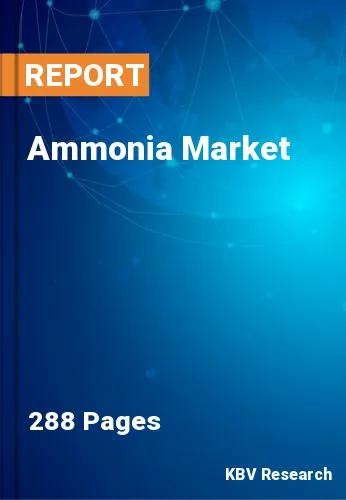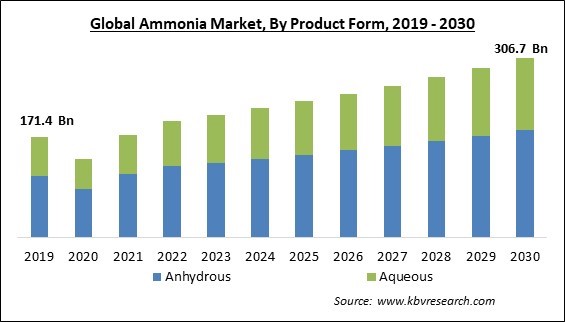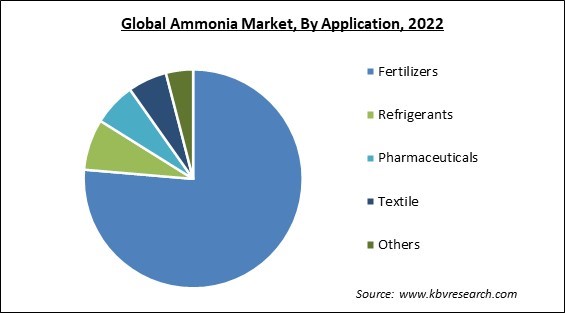
The Global Ammonia Market size is expected to reach $306.7 billion by 2030, rising at a market growth of 5.6% CAGR during the forecast period. In the year 2022, the market attained a volume of 2,13,071.9 Kilo Tonnes, experiencing a growth of 4.6% (2019-2022).
Ammonia is not commonly used in textiles, but its derivative, ammonium hydroxide (NH4OH), often referred to as ammonia solution or simply ammonia, has some applications in the textile industry. Therefore, textile sector generated $11,509.5 million revenue share in 2022. In the textile industry, desizing removes sizing agents applied to warp yarns to make them more resistant to abrasion during weaving. Ammonium hydroxide can be used as a desizing agent to break down and remove these sizing materials from textiles. Ammonium hydroxide is sometimes used as a component of dye pastes and printing inks. It can help in the fixation of dyes on textiles during the printing process, particularly in pigment printing. Some of the factors impacting the market are rising fertilizer consumption and increased agricultural production, growing applications in the refrigeration systems and mining industry, and impacts of exposure to high concentrations of NH3 on humans.

Modern farming practices, including precision agriculture, emphasize optimizing fertilizer application to maximize yields while minimizing waste. This approach can result in increased ammonia use per hectare of cultivated land. Many governments support agricultural development and food security by subsidizing fertilizers or implementing policies to promote their use. Such initiatives can stimulate ammonia consumption in agriculture. Fertilizers, including those produced with ammonia, allow farmers to diversify crops and cultivate higher-value, nutrient-demanding varieties. This diversification can lead to greater ammonia utilization. The growth in fertilizer consumption driven by the need for increased agricultural production contributes to the expansion of the ammonia market.
Additionally, the mining industry relies on ammonia to produce explosives, particularly ammonium nitrate-based explosives. Ammonium nitrate is a vital component used in the mining and construction sectors for tasks such as blasting and excavation. It is used as a leaching agent or solvent in metallurgical processes, such as leaching and ore refining. It plays a role in extracting valuable metals from ores. Ammonia is used in some mining operations for dust suppression. It can help control dust and improve safety in mining environments. Expanding applications beyond agriculture has diversified the ammonia market, reducing dependence on a single sector. The mining industry's demand for ammonia has grown as mining activities have expanded, particularly in emerging economies with substantial mining operations. The above factors will lead the market growth in the coming years.
However, the majority of individuals are exposed to NH3 by inhaling vapors or gas. Since the substance occurs naturally and is present in cleaning products, people are likely exposed to such sources. It has an immediate effect upon contact with the eyes, epidermis, respiratory tract, and oral cavity. Low ammonia concentrations in solutions or air can rapidly irritate the eyes and epidermis. Greater concentration may result in severe burning and injuries. Any contact with highly concentrated solutions, such as industrial cleaners, can result in corrosive injuries, such as skin burns and permanent eye damage or blindness. In addition to these effects, swallowing solutions at high concentrations cause corrosive harm to the stomach, throat, and mouth. In the future, market growth will be hampered by these factors.
Based on application, the market is fragmented into fertilizers, refrigerants, pharmaceuticals, textile, and others. In 2022, the fertilizers segment held the highest revenue share in the market. Farmers increasingly utilize nitrogenous fertilizers due to their high solubility, which enables plants to absorb them swiftly and effectively. This means they can supply the nitrogen necessary for plant growth more quickly than organic fertilizers, which require time to break down and release nutrients. Ammonia is one of the most frequently utilized nitrogenous fertilizers and is the fundamental compound of the nitrogen industry. In addition, NH3-based fertilizers can be manufactured in various forms and adapted to various agricultural settings and crops.

On the basis of product form, the market is segmented into aqueous and anhydrous. In 2022, the aqueous segment acquired a substantial revenue share in the market. This is because it is easy to handle and easily available to producers. In addition, nitrogenous fertilizers based on NH3 offer improved yield, effective protection for crops, and improved farming cycles. Due to its increased nitrogen content of 82%, this anhydrous product-based fertilizer is utilized extensively in agriculture. However, it is more efficacious in warmer temperatures than in cooler temperatures. Its pungent odor and high vaporization temperature make anhydrous ammonia useful as a solvent and refrigerant. Liquefied NH3 is also utilized in producing synthetic fibers, pharmaceuticals, and mining metals from ore.
| Report Attribute | Details |
|---|---|
| Market size value in 2022 | USD 199.3 Billion |
| Market size forecast in 2030 | USD 306.7 Billion |
| Base Year | 2022 |
| Historical Period | 2019 to 2021 |
| Forecast Period | 2023 to 2030 |
| Revenue Growth Rate | CAGR of 5.6% from 2023 to 2030 |
| Number of Pages | 288 |
| Number of Table | 530 |
| Quantitative Data | Volume in Kilo Tonnes, Revenue in USD million, and CAGR from 2019 to 2030 |
| Report coverage | Market Trends, Revenue Estimation and Forecast, Segmentation Analysis, Regional and Country Breakdown, Companies Strategic Developments, Company Profiling |
| Segments covered | Product Form, Application, Region |
| Country scope | US, Mexico, Canada, Russia, France, Germany, UK, Spain, Italy, China, India, Thailand, Japan, South Korea, Australia, Brazil, Argentina, South Africa, Nigeria, Morocco, Chile |
| Growth Drivers |
|
| Restraints |
|
Region-wise, the market is analysed across North America, Europe, Asia Pacific, and LAMEA. In 2022, the Asia Pacific region generated the highest revenue share in the market. The Asia-Pacific region dominates the market due to large consumption from countries such as China, India, Japan, and others. China is one of the largest producer and consumer of ammonia in the world. The demand for ammonia in the country is rising due to increasing applications in the agriculture industry, such as fertilizers, textiles, pharmaceuticals, and mining. China leads the world in nitrogen (N) fertilizer consumption. Japan has a long tradition in textile production and is one of the largest manufacturers of technical textiles. Thus, all the above-mentioned factors will likely increase the market demand during the forecast period.
Free Valuable Insights: Global Ammonia Market size to reach USD 306.7 Billion by 2030
The market research report covers the analysis of key stake holders of the market. Key companies profiled in the report include SABIC (Saudi Arabian Oil Company), Linde PLC, Yara International ASA, Nutrien Limited, BASF SE, Sumitomo Chemical Co., Ltd., Koch Industries, Inc. (Molex LLC), CF Industries Holdings, Inc., Qatar Fertiliser Company (Industries Qatar), and PJSC Togliattiazot.
By Product Form (Volume, Kilo Tonnes, USD Million, 2019-2030)
By Application (Volume, Kilo Tonnes, USD Million, 2019-2030)
By Geography (Volume, Kilo Tonnes, USD Million, 2019-2030)
>This Market size is expected to reach $306.7 billion by 2030.
Rising fertilizer consumption and increased agricultural production are driving the Market in coming years, Impacts of exposure to high concentrations of NH3 on humans restraints the growth of the Market.
SABIC (Saudi Arabian Oil Company), Linde PLC, Yara International ASA, Nutrien Limited, BASF SE, Sumitomo Chemical Co., Ltd., Koch Industries, Inc. (Molex LLC), CF Industries Holdings, Inc., Qatar Fertiliser Company (Industries Qatar), and PJSC Togliattiazot.
In the year 2022, the market attained a volume of 2,13,071.9 Kilo Tonnes, experiencing a growth of 4.6% (2019-2022).
The Anhydrous segment is leading the Market, By Product Form in 2022, thereby achieving a market value of $183.6 Billion by 2030.
The Asia Pacific region dominated the Market, By Region in 2022, and would continue to be a dominant market till 2030; thereby, achieving a market value of $161.3 Billion by 2030.
Our team of dedicated experts can provide you with attractive expansion opportunities for your business.
